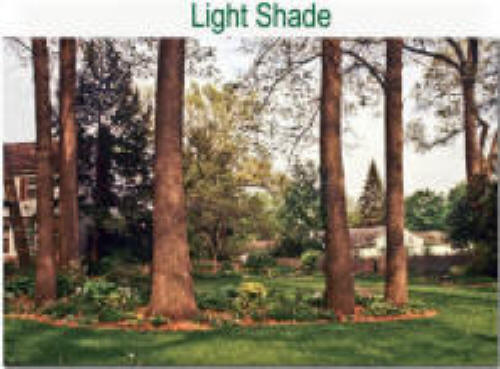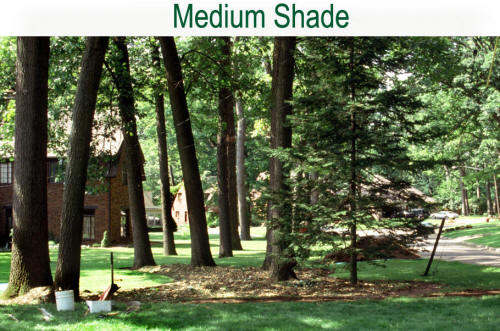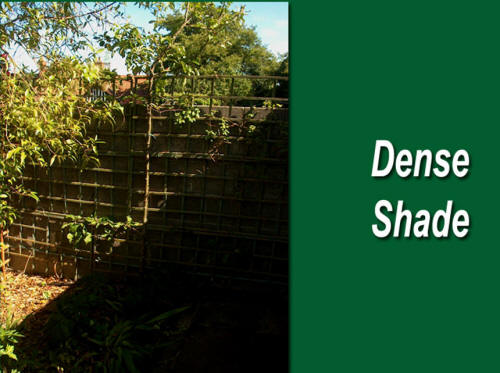Hostas are often called "shade loving" plants.
For the average gardening public, this helps them to understand that
these plants are adapted to growing in the shade. However, for more
advanced hobbyists or professionals, this is a misnomer.
All vascular plants live by a process called
photosynthesis. They capture the energy from the sun and, unlike
animals, they make their own food. For photosynthesis to work, a
plant must have five things including light, water, nutrients from
the soil and the air,
chlorophyll and suitable temperature. The
minimum levels of each of these factors required may vary from
species to species but they all must be present in certain amounts
for photosynthesis to take place in that plant.
For a plant to be truly a "shade lover" would
imply that it could complete photosynthesis in a dark closet. That
is clearly not the case here, so hostas are actually "shade
tolerant" plants which can survive and often thrive at low (but not
zero) light levels. In fact, most of them will do best in more sun
but, to keep them aesthetically pleasing, we sometimes have to make
concessions. More on that later.
When people classify themselves as either a
"shade" or a "sun" gardener, they often act as if we should all
understand exactly what they mean. Here again, those terms can bring
to mind a wide range of light conditions. For purposes of this
eBook, we will define garden light levels as follows:
_ 1. Full Sun - Plants that are
designated as full sun plants are usually those that are native to
open, prairie or swampy type environments that support few or no
trees. They are conditioned to having sunshine hit their leaves from
sunup in the morning until sundown in the evening. That is the
accurate definition of FULL SUN!
 However, over the years, gardeners and
horticulturists have come to understand that these plants can still
perform adequately while being exposed to less than total sunlight
all day long. The common rule of thumb is that you need a MINIMUM of
around 6 hours of direct sunlight per day for these plants to
thrive. Full sun plants that get less than that amount will develop
stems that are overly long and weak i.e. etiolated, which tend to
fall over. Such plants will not flower well and will not be as
vigorous as those getting more sunlight. Just remember that those 6
hours are a minimum and more would be better. However, over the years, gardeners and
horticulturists have come to understand that these plants can still
perform adequately while being exposed to less than total sunlight
all day long. The common rule of thumb is that you need a MINIMUM of
around 6 hours of direct sunlight per day for these plants to
thrive. Full sun plants that get less than that amount will develop
stems that are overly long and weak i.e. etiolated, which tend to
fall over. Such plants will not flower well and will not be as
vigorous as those getting more sunlight. Just remember that those 6
hours are a minimum and more would be better.
_ 2. Shade - So, if 6 hours is
needed for full sun, it would be a simple conclusion to assume that
shade plants can live and even thrive in less than 6 hours. Again,
although we talk about shade as if it were a single unit, the
reality is that there are generally considered to be 3 categories of
shade in the home landscape.

_ a. Light Shade a.k.a. Dappled
Shade or Partial Shade - This is the situation where you have
just a few trees in the landscape or when you have trees with small
leaves such as honeylocust. As the sun passes over the horizon, the
plants in the shaded areas may receive a total of up to 5 or 6 hours
of direct sunlight. The key is that they will get it a few hours
here, an hour there and another hour later. It will not be 5 or 6
hours in a row. This will be a great growing environment for our
shade tolerant plants.

_ b. Medium Shade a.k.a. Open Shade
or High Shade - This is the situation when you have many large
deciduous trees such as oaks where the bottom branches may be 20 or
30 feet off the ground. As the sun passes over head, the plants
beneath may only receive direct sunlight for a couple of hours total
during the day but the environment is generally "bright". In this
landscape, a person could take a seat under the trees and easily
read a book but rarely have direct sunlight penetrate onto the
paper. This is also a very good environment for shade tolerant
plants.

_ c. Deep Shade a.k.a. Dark Shade
or Dense Shade - Deep shade will occur beneath evergreen trees
such as pines or spruce or deciduous trees with large leaves such as
Norway maples. This will also be the case close to the north side of
buildings. Under these conditions, as the sun moves across the
horizon during the day, no direct rays will strike the plant. The
only light will be that which is reflected back into the dark from
the surroundings.
This is a very difficult environment for
growing shade tolerant plants. Hostas and others will usually
survive these conditions but they will not thrive. For instance,
hostas growing under the first two levels (a & b) of shade will add
new divisions to the clump at a rate consistent with that expected
of a particular cultivar. Those same hostas grown in the deep shade
will multiply at a much, much slower rate, if at all. They will also
develop thinner and, often, fewer leaves than would the same
cultivar planted in shade levels a and b.
|



